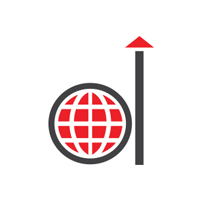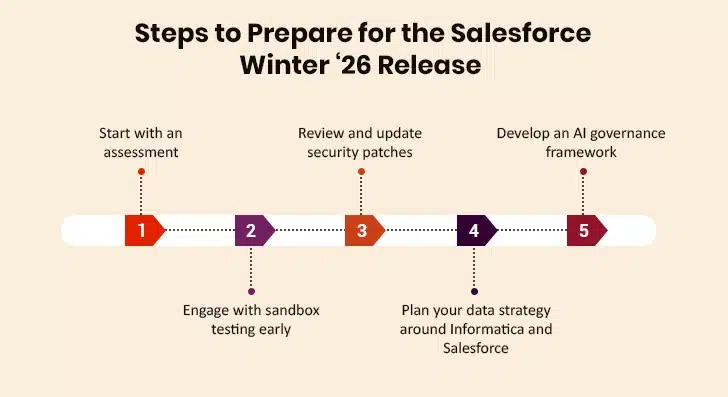Salesforce releases never fail to surprise, do they?
With updates rolled out thrice a year, Spring, Summer, and Winter, Salesforce is among the few technology companies that not only promise tangible value throughout the year for enterprises but deliver as well. It may be only a month that the Summer ‘25 release was made available, but the Winter ’26 release is not far either. If your enterprise has already implemented all the latest updates, now is the right time to plan for what’s coming this winter.
Following the significant developments in recent releases, particularly the introduction of Agentforce and the Informatica acquisition, the upcoming release promises to be a big one. While many speculations are being made around the Winter ‘26 release, we’ve compiled the five things that we can expect from this update. Along the way, we’ll also share how your organization can prepare for these changes.
Table of Contents
What’s Expected in Salesforce Winter ’26?
- 1. Data Security and Governance Enhancements Across Salesforce
- 2. Another Agentforce Update on the Cards?
- 3. Permission and User Access Enforcements (Confirmed in Winter ‘26)
- 4. Service Cloud and Experience Cloud Feature Upgrades
- 5. Integrated Data Management with Salesforce + Informatica
Release Timeline: When to Expect Salesforce Winter ’26?
What’s Expected in Salesforce Winter ’26?
What’s Expected in Salesforce Winter ’26?
1. Data Security and Governance Enhancements Across Salesforce
Data security is the foundation of any trustworthy AI ecosystem. It won’t be a surprise to see advanced encryption protocols, improved identity management systems, and more granular control over data access permissions in the Winter ‘26 release. As more enterprises sign up for sensitive customer data, Salesforce is likely to introduce new compliance tools. New compliance tools would make it easier for your teams to meet evolving regulatory requirements like GDPR, CCPA, and other emerging AI governance standards.
The focus will also be on Zero Trust architecture principles. This means that your interaction within the Salesforce environment will be fully secure. You can expect more multi-factor authentication (MFA) options, session management improvements, and more sophisticated threat detection capabilities.
2. Another Agentforce Update on the Cards?
While there was initial speculation about another major Agentforce release before September, this is unlikely to happen. This is due to the extensive Agentforce 3 rollout timeline that already extends through August 2025.
Available Now: Core Agentforce 3 capabilities, adoption analytics, Testing Center enhancements, and over 100 new pre-built industry actions.
Coming in July: Anthropic Claude models integration, MuleSoft MCP and A2A support, Heroku AppLink, and Agentforce native MCP support.
Coming in August: Session Tracing Data Model, Agent health monitoring, and the highly anticipated Agentforce Command Center & Agentforce Studio app.
Once all the Agentforce 3 features are made available by the end of August 2025, enterprises can take advantage of the Winter ’26 release. With Agentforce’s core components—Command Center, Modular Context Protocol (MCP), and 100+ pre-configured AI agent actions on AgentExchange—already implemented and operational, businesses can seamlessly transition into Winter ’26. This ensures teams will have time to adapt to new workflows, configure agents for domain-specific use cases, and test cross-cloud automation strategies. More importantly, it sets the stage for deeper Einstein integrations, and more secure flow executions.
3. Permission and User Access Enforcements (Confirmed in Winter ‘26)
Winter ’26 introduces several critical permissions and user access enforcement features that were previously postponed from earlier releases. Unlike other updates, these are confirmed and will be rolled out with the Winter ’26 release.
I. Permission Requirements for Built-In Apex Classes
This update was previously expected in Spring ’25. This will now be available with the Winter ’26 release. Basically, this is about making sure that the permission requirements are properly implemented for file-based Apex classes used as inputs for Apex actions. With the next Salesforce release, Apex actions will operate within the current component context, preventing flow interview failures that occur when flows include Apex actions with file-based classes requiring specific permissions.
If your organization is using custom Apex actions in flows, you might want your team to review the current implementations and ensure proper permissions are in place to avoid disruptions.
II. Migration from Maintenance Plan Frequency Fields to Maintenance Work Rules
After multiple postponements since Winter ’22, this update will finally be enforced in Winter ’26. The Frequency and Frequency Type fields on Maintenance Plans are being retired, requiring organizations to migrate their data to the updated maintenance work rules system.
This change affects organizations using Salesforce Field Service and requires proper migration planning to ensure continuity of maintenance scheduling processes.
III. Restricted User Access to Run Flows
Initially planned for Winter ’25, this security enhancement will now be enforced in Winter ’26. This update strengthens flow execution security by requiring users to have specific profile or permission set grants to run flows. The FlowSites org permission, which previously allowed all users to run any flow, will be deprecated. You might want to review your current flow usage patterns and assign appropriate permissions to users who need to execute flows.
Navigating Modern Salesforce AI Stack and Implementation Framework
4. Service Cloud and Experience Cloud Feature Upgrades
The Service Cloud and Experience Cloud might be upgraded to focus more on smart content management and AI-powered customer insights. One of the most anticipated features might be Einstein Article Recommendations, which may use AI to suggest the most relevant help articles to both agents and customers in real time.
This intelligent content system would understand context, user intent, and historical patterns to surface the most helpful information at the right moment. For customer service teams, this means even faster resolution times and more consistent support quality. For customers, it means getting answers exactly when they need them.
Additionally, it would make sense to expect enhanced personalization capabilities based on customer preferences, past interactions, and predictions. With so much going on already in terms of hyper-personalization, there’s a good chance that the Experience Cloud might introduce new templates and components that make it easier to create highly personalized digital experiences without requiring extensive development resources.
5. Integrated Data Management with Salesforce + Informatica
The biggest story heading into Winter ’26 is undoubtedly Salesforce’s recent acquisition of Informatica for approximately $8 billion in equity, announced in May 2025.
“This combination brings together Salesforce’s Einstein and Informatica’s CLAIRE AI engines to forge the ultimate AI-data platform — trusted, explainable, and built to scale. Together, we’ll supercharge Agentforce, Data Cloud, Tableau, MuleSoft, and Customer 360, enabling autonomous agents to act with intelligence, context, and confidence across every enterprise. This is a transformational step in delivering enterprise-grade AI that is safe, responsible, and deeply integrated with the world’s data.”
— Marc Benioff, Chair and CEO of Salesforce
The combination of Informatica’s AI-powered cloud data management capabilities with Salesforce’s AI CRM platform will create what Salesforce calls “a unified data architecture for agentic AI”, enabling AI agents to operate safely, responsibly, and at scale across the modern enterprise landscape.
The integration essentially focuses on how to prepare for effective enterprise-grade AI solutions leveraging the power of data. And here are the important components:
Data Transparency: Informatica’s advanced integration, catalog, and lineage tools show where data comes from, how it has changed, and how it is used. This is crucial for auditability and regulatory compliance. This also means that your AI agents will have complete visibility into data, essential for maintaining trust and meeting regulatory requirements.
Data Understanding: Informatica’s rich metadata, combined with Salesforce’s unified data model, will empower AI agents to interpret, connect, and act on enterprise data in a meaningful context. Your AI agents won’t just see data points—they’ll understand their full context, origin, transformation history, and quality indicators.
Data Governance: Built-in MDM, data quality controls, and policy management ensure that all data being used by AI is standardized, accurate, consistent, and secure. With this, AI agents will be able to make better decisions, thanks to enterprise-grade data quality.
Now, let’s see the specific capabilities that the Salesforce Informatica integration is set to bring across the Salesforce ecosystem:
- Data Cloud Enhancement: Informatica will strengthen Data Cloud’s leadership as a Customer Data Platform (CDP), ensuring data from across the organization is not just unified but clear, trusted, and actionable.
- Agentforce Improvement: AI agents will gain a critical foundation for autonomous AI agents to interpret and act on complex enterprise data, building a true system of intelligence on a trusted system of understanding.
- MuleSoft Governance: Informatica’s advanced data quality, integration, cataloging, and governance will ensure that the data flowing through MuleSoft APIs is enriched, standardized, and trustworthy.
- Tableau Insights: Users will benefit from richer, context-driven insights, thanks to a more accessible and holistic data landscape.
While the complete transaction between both the parties is expected to close early in Salesforce’s fiscal year 2027 (as per the official Salesforce press release), enterprises can see minor updates at the data level in the Winter ‘26 release. As with every other integration, the new capabilities are eventually infused in the Salesforce ecosystem, and then the rollout happens. From Salesforce’s perspective, the idea would be to prepare the orgs for embedding the Informatica integration layer.
For enterprises currently using either platform, this integration promises to eliminate data silos, improve AI decision-making accuracy, and provide the data governance foundation necessary for enterprise-scale AI deployment.
Release Timeline: When to Expect Salesforce Winter ’26?
Salesforce Winter ‘26 will be released in the fall. However, you can get a preview of the features and updates starting in September.
| Release Version | Preview Start Date | Preview End Date |
|---|---|---|
| Summer ’25 | May 11, 2025 | June 14, 2025 |
| Winter ’26 | September 7, 2025 | October 11, 2025 |
| Spring ’26 | January 11, 2026 | February 21, 2026 |
Pre-release Phase (September 2025): First, the sandbox environment will receive the Winter ’26 updates. This enables you to check out the new features in a safe environment. It’s important to note that preview instances typically get access first, followed by non-preview sandboxes.
General Availability (October 2025): Production instances will start receiving the Winter ’26 release in phases. Salesforce typically rolls out updates across different server instances over several weekends to ensure stability and minimize disruption.
Full Deployment (November 2025): By early November, all production instances should have the Winter ’26 features enabled and available.
It’s worth noting that some features may be released earlier through Salesforce’s continuous delivery model, while others might be gradually rolled out to different user tiers throughout the release window. There’s no official confirmation on this yet.
How to Prepare for the Salesforce Winter ’26 Release?
The better you prepare, the more value you get out of a major Salesforce release. Here’s a how enterprises can prepare one step at a time to get ready for the Winter ‘26 release:
I. Start with an Assessment
Before you can leverage new features, you need to understand where you stand today. Assess your implementation, including customizations, integrations, AI agents, and user permissions. Pay particular attention to any custom code or third-party applications that might be affected by the new security and permission enhancements.
Document your existing data governance practices. When the official statement is released, quickly identify areas where the new security features could provide immediate value. This assessment will help you prioritize Winter ’26 features to implement first.
II. Engage with Sandbox Testing Early
As soon as the Winter ’26 features become available in sandbox environments, start testing them with real-world scenarios. Consider critically testing the new Agentforce capabilities with your actual customer data (or synthetic data). Remember, the output/result of your AI agents is directly proportional to the quality of data in your Salesforce org.
III. Review and Update Security Policies
With new data security features planned for Winter ‘26, it’s important that your organization’s security policies and procedures will require changes. Work with your IT security team to understand how the new capabilities align with your overall security strategy. Consider conducting security training sessions for your users. The more sophisticated these systems become, the more important it is that your users understand how to work within them effectively.
IV. Plan Your Data Strategy Around Informatica Integration
If your organization currently uses other data integration tools, now is the time to evaluate how the new Informatica capabilities might simplify your tech stack. Assess your existing data workflow. Pinpoint how Informatica-Salesforce integration can come in handy. This is also an excellent time to implement data governance best practices that will be essential for maximizing the value of AI-driven features.
V. Develop an AI Governance Framework
With Agentforce updates coming in every three or four months, it’s high time that your organization defines clear guidelines about how AI agents should interact with customers and handle sensitive data. Develop policies around AI decision-making, escalation procedures, and quality assurance processes. Consider stakeholders from your IT, legal, customer service, and business operations team to ensure your AI governance framework addresses all relevant concerns and use cases.
Ending Note
The Winter ’26 release is expected to lay the foundation for an AI-first, data-driven future in customer relationship management. The combination of enhanced security, more powerful AI agents, and unified data management generates fresh opportunities for enterprises to deliver more personalized and smart customer experiences at scale. Enterprises that invest time now in anticipating what’s coming their way this winter will undoubtedly have an edge in 2026 and beyond.
As we await the official release notes and detailed feature announcements, the key is to start preparing now. Getting in touch with a registered Salesforce consulting partner might help you better prepare for the Winter ‘26 release.







